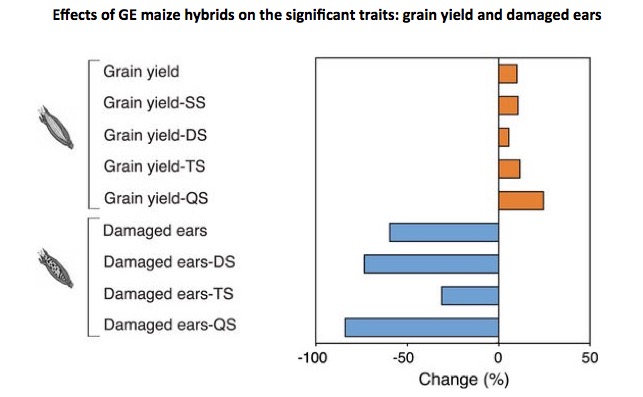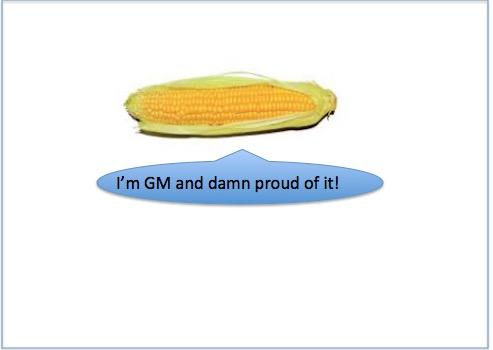Never let the facts get in the way of a good story. Here is my message to various environmental groups, organic food companies, and anti-whatever activists: Your stance on GM food is way off. And there is a new paper in Nature that confirms this, at least with regard to GM corn. The title itself says much about the paper:
"Impact of genetically engineered maize on agronomic, environmental and toxicological traits: a meta-analysis of 21 years of field data"
The paper is an examination of multiple studies (meta-analysis) of peer-reviewed literature between 1996-2006, which addresses the agricultural, environmental, and toxicological effects of GM corn. Its conclusions are compelling. The bottom line is that the rumors, scaremongering, and doomsday scenarios about the effect of consumption of GM corn are wrong. Seriously so. Although "counterintuitive," GM corn is better for both you, agriculture, and the soil, despite a long-running narrative to the contrary. It's all quite interesting. Let's take a look, but first a bit about meta-analyses - studies of other studies. They vary in quality. Some are worthless. This one was good. American Council advisor and biostatistics expert Dr. Stan Young explains:
"A meta-analysis using results from designed experiments will always be superior than one based on observational results. In a designed experiment the researcher selects the treatments and assigns them to the experimental material or units at random so that any characteristics of the experimental units tend to balance out any accidental biases in the experiment. In this case, the papers that were selected were designed experiments so the data coming from them should be fine."
Stan Young Ph.D.
Laura Ercoli at the Institute of Life Sciences, Scuola Superiore Sant’Anna in Pisa, Italy, and colleagues conducted a long and technical study - one that is far beyond the scope of this article. But there are some clear and valuable take-home lessons that can be extracted from the study, which initially began from analysis of 6,006 (!) peer-reviewed publications. After applying rigorous criteria, the group pared that number down to 79 studies, which focused on measurements of grain yield and quality, environmental impact, and human health.
IMPACT ON AGRICULTURE
- GM corn produced 5.6-24.5% more grain than the natural plant
- The number of damaged ears was lower
- Both of these effects can be seen in Figure 1.

Figure 1. Comparison of GM and "traditional" - yield and corn ear damage. Yields are higher and ear damage is lower in GM corn. The qualifiers DS, TS, and QS represent different statical methods. Source: Modified graphic from Scientific Reports.
HUMAN HEALTH - COMPARISON OF THE PRODUCTION OF FUNGAL TOXINS
- Mycotoxins are a group of toxic chemicals and metabolites produced by fungi. Fungi grow readily in grains, including corn. Perhaps the best-known mycotoxin is aflatoxin, which is found in moldy peanuts. Mycotoxins are potent poisons and can cause death. They are also carcinogens.
- GM corn contained 29% fewer mycotoxins than non-GM corn.
- Fumonisins are a group of about 30 different toxins produced by a fungus. Animals that consume contaminated feed experience drowsiness, blindness, staggering, and liquefaction of brain tissue and death.
- GM corn contained 31% fewer fumonisins than non-GM corn.
- Trichothecenes are a very large family of chemically-related, highly potent toxins, which act by binding to ribosomes and disrupting protein biosynthesis. Symptoms of trichothecene are similar to that of radiation.
- GM corn contained 37% fewer trichothecenes than non-GM corn.
People who are concerned about the health effects of GM foods or glyphosate residues ought to think about this.
ENVIRONMENTAL CONCERNS: HARM TO NON-TARGET ORGANISMS
- A long-prevailing concern about GM foods (as well as pesticides) is that they will kill organisms other than those they are supposed to kill.
- The genetic modification in corn adds a gene that produces a toxic protein from the bacterium Bacillus thuringiensis (Bt). This Bt toxin kills caterpillars and beetles that attack corn. Bt toxin has long been used as an insecticide and is non-toxic to mammals and humans. (Bt "donuts" are used to kill mosquito larvae (but not adult mosquitos). You have probably seen them placed in standing water.
- The report concluded that there was "modest or no effect on the abundance of non-target insects, suggesting no substantial effect on insect community diversity."
- It's safe.
"In conclusion, our meta-analysis of 21 years of field data on the agro-environmental impact of GE maize clearly shows the benefits in terms of increases in grain yield and quality, and in decreases of the target insect Diabrotica spp. Our analysis highlights modest or no effect on the abundance of non-target insects, suggesting no substantial effect on insect community diversity... We provide also strong evidence that GE maize cultivation reduces mycotoxin content in grain. Since mycotoxin contamination in maize grain annually leads to high economic losses in all regions of the world, the protection of maize plants through the use of GE technology against the damage of insects..."
Products from GM corn are all over the place. They are not harming anyone, except possibly the people who pay for at Whole Foods to avoid them.




